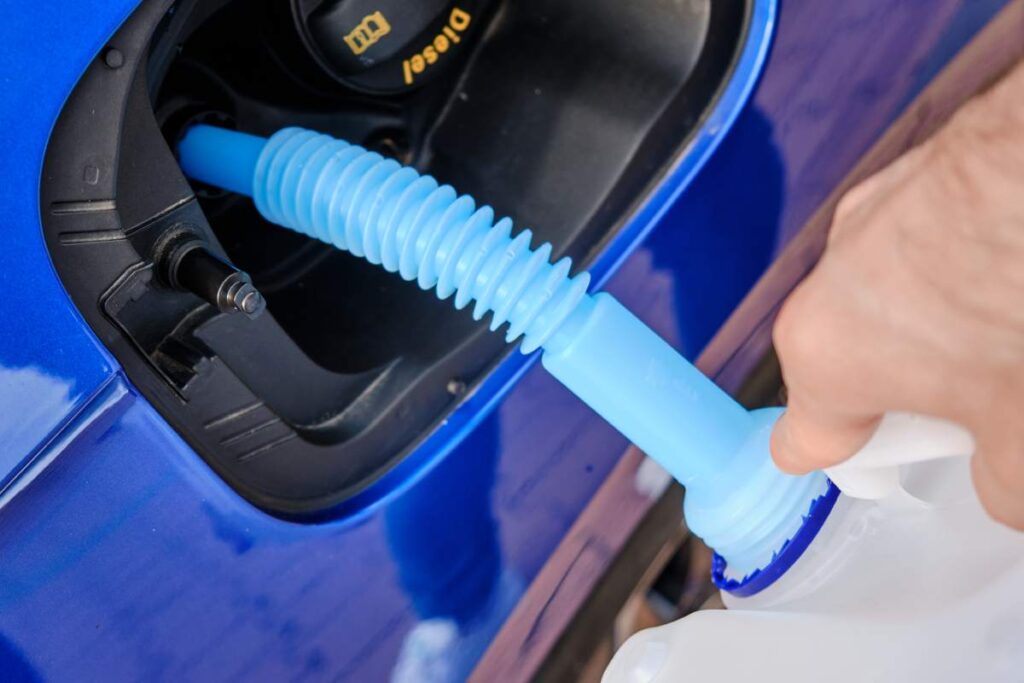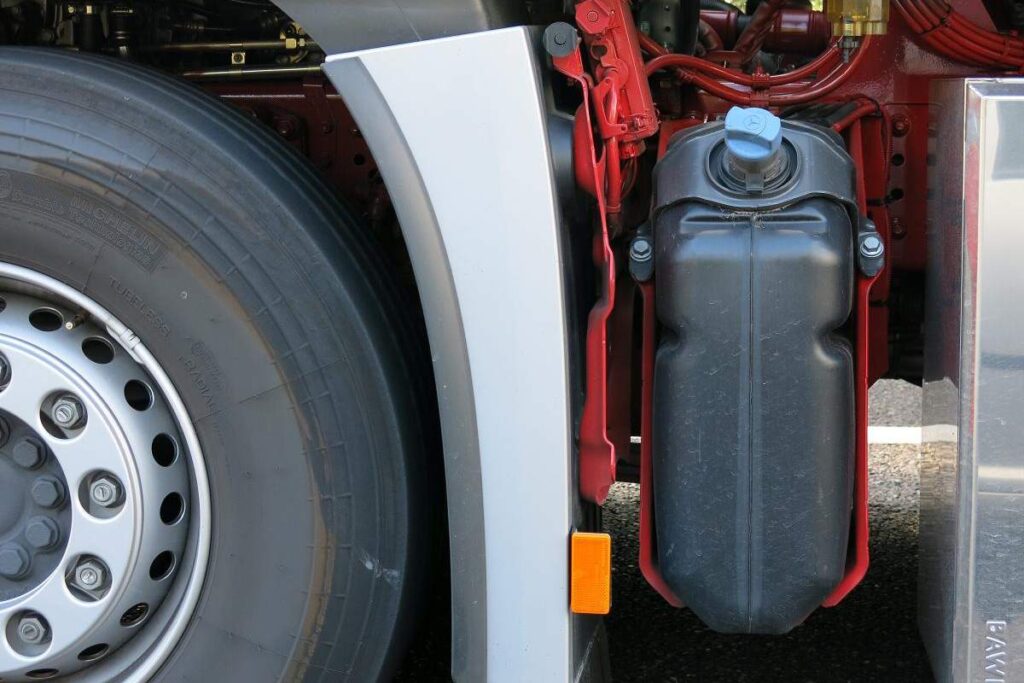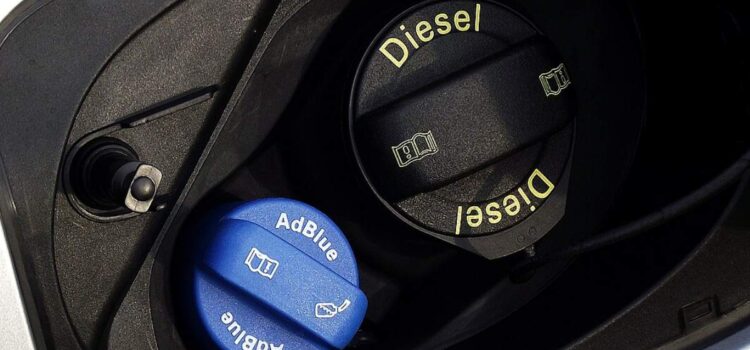AdBlue is a term becoming increasingly familiar to vehicle owners, particularly those who drive diesel-powered cars. As environmental regulations tighten globally, technologies like AdBlue are crucial in reducing harmful emissions.
This article explores what AdBlue is, its composition, and how it plays a vital role in making diesel engines more environmentally friendly.
- What is Engine Braking? Is it Different from Normal Brakes?
- How to Know if Your Tyres Have Gone Bad and When to Change Them
- What is the EU Tyre Label?
What Is AdBlue?
AdBlue is a high-purity urea solution designed to reduce harmful emissions from diesel engines. It is not a fuel additive but a separate fluid stored in a dedicated tank within vehicles equipped with Selective Catalytic Reduction (SCR) systems.
AdBlue is a trademarked name registered by the German Association of the Automotive Industry (VDA), but similar products are available under other names, all adhering to the same ISO 22241 standard.
The primary purpose of AdBlue is to reduce nitrogen oxide (NOx) emissions, which are a major contributor to air pollution and are regulated strictly in many countries.
What Is AdBlue Made Of?
AdBlue is a simple mixture of two main components:
- Deionized Water (67.5%)
The majority of AdBlue is made up of deionized water. This ultra-pure water prevents contaminants from clogging or damaging the SCR system. - Urea (32.5%)
AdBlue’s urea is a highly refined, automotive-grade product. Urea, a nitrogen compound, is widely used in agriculture as a fertilizer. However, the urea in AdBlue is much purer than agricultural-grade urea and is synthesized to meet stringent automotive standards.
AdBlue is non-toxic, non-flammable, and safe to handle, although it can cause minor irritation to the skin or eyes. It is also biodegradable, which ensures minimal environmental impact during production and disposal.

How Does AdBlue Work?
AdBlue works through a process called selective catalytic reduction (SCR), which is a cutting-edge emissions control technology. Here’s a step-by-step explanation of how it functions:
1. Injection into the Exhaust System
AdBlue is injected into the vehicle’s exhaust system, not the engine, at specific operating stages. This occurs downstream of the engine, where the exhaust gases are hottest.
2. Thermal Decomposition
When exposed to the high temperatures in the exhaust system, AdBlue decomposes into ammonia (NH₃) and carbon dioxide (CO₂).
3. Reduction of NOx to Harmless Gases
The ammonia reacts with nitrogen oxides (NOx) in the exhaust gases in the presence of a catalyst. This reaction converts the harmful NOx into nitrogen (N₂) and water (H₂O), both of which are harmless and naturally occur in the atmosphere.
4. Emission of Clean Exhaust
The treated exhaust is released into the atmosphere, significantly reducing the environmental impact of diesel engines.
Why Is AdBlue Important?
The growing focus on reducing vehicle emissions has made AdBlue a critical component in modern diesel engines. Here’s why:
1. Reduction of NOx Emissions
Nitrogen oxides contribute to smog, acid rain, and respiratory problems. By breaking down NOx into benign components, AdBlue helps meet stringent environmental standards.
2. Compliance with Regulations
Many countries require vehicles to adhere to Euro 6 or equivalent emissions standards. AdBlue-enabled SCR systems are an effective way for manufacturers to comply with these regulations.
3. Improved Air Quality
By lowering harmful emissions, AdBlue contributes to better air quality, particularly in urban areas where vehicle emissions are a significant problem.

Who Needs AdBlue?
AdBlue is necessary for any vehicle equipped with an SCR system. This technology is commonly found in:
- Passenger Cars: Many modern diesel cars require AdBlue to meet emissions standards.
- Trucks and Buses: Heavy-duty vehicles often rely on SCR technology due to their higher emissions output.
- Agricultural and Construction Equipment: AdBlue is also used in off-road machinery to minimize environmental impact.
If your vehicle requires AdBlue, you’ll typically see a blue filler cap next to the diesel tank or elsewhere in the vehicle, such as under the hood or in the trunk.
How to Use AdBlue
If your vehicle uses AdBlue, it’s important to keep the tank adequately filled. Most vehicles will notify you via a dashboard warning when AdBlue levels are low.
Tips for Using AdBlue:
- Refill Regularly
AdBlue consumption varies depending on the vehicle and driving style but is usually around 1 litre per 1,000 kilometres. Running out of AdBlue will cause most vehicles to enter a restricted performance mode or fail to start altogether. - Use Only Approved Products
Ensure you use ISO 22241-compliant AdBlue to avoid damaging your SCR system. - Store Properly
AdBlue should be stored in a cool, dry place away from direct sunlight. Extreme heat or freezing conditions can degrade its quality. - Handle With Care
Spills can crystallize and damage vehicle surfaces, so clean up any spills promptly.
Environmental Benefits of AdBlue
AdBlue contributes to environmental protection by enabling diesel engines to operate more cleanly. This has several benefits:
- Lower Greenhouse Gas Emissions: While AdBlue doesn’t reduce CO₂ directly, the reduced NOx emissions help mitigate overall environmental harm.
- Healthier Urban Environments: By reducing smog-forming pollutants, AdBlue helps create cleaner air in cities.
- Sustainability in Diesel Technology: AdBlue allows diesel engines to remain viable in an increasingly eco-conscious market.
Challenges and Limitations
Despite its benefits, AdBlue has some drawbacks:
- Additional Maintenance
Vehicle owners must regularly refill AdBlue, which adds to maintenance tasks. - Storage Concerns
AdBlue has a limited shelf life, especially when exposed to extreme temperatures. - Cost
While not overly expensive, the cost of AdBlue can add up for heavy users. However, the environmental and compliance benefits often outweigh these costs. - Dependency on Availability
Although widely available at fuel stations and automotive stores, a lack of AdBlue can render vehicles inoperable.
Where to Buy AdBlue?
AdBlue is readily available at:
- Fuel Stations: Many stations now have AdBlue pumps for refilling.
- Automotive Stores: Pre-packaged AdBlue is sold in various sizes for convenience.
- Online Retailers: Reliable suppliers like EcoBlue.com offer certified AdBlue products for delivery, ensuring quality and convenience.
The Future of AdBlue and Emissions Control
As emissions regulations continue to evolve, AdBlue and SCR technology will remain integral to diesel vehicles. Innovations may further improve efficiency, reduce costs, and enhance convenience for users.
With the global push towards cleaner energy, hybrid and fully electric vehicles are gaining popularity. However, diesel engines are still essential for many applications, making solutions like AdBlue indispensable in the transition to greener transportation.
Conclusion
AdBlue is a simple yet powerful tool in the fight against vehicle emissions. Made from high-purity urea and deionized water, it works through SCR technology to convert harmful nitrogen oxides into harmless nitrogen and water vapour. While it requires regular maintenance and proper handling, its environmental and regulatory benefits make it an essential component for modern diesel engines.
By understanding how AdBlue works and incorporating it into vehicle maintenance routines, drivers can contribute to a cleaner, healthier environment while ensuring compliance with emission standards. Whether you’re a long-haul truck driver or a city commuter, AdBlue is a step toward sustainable driving.






